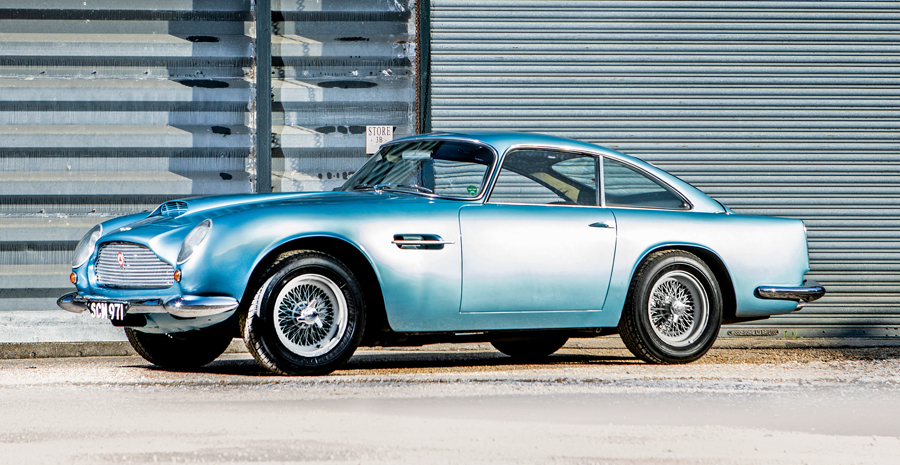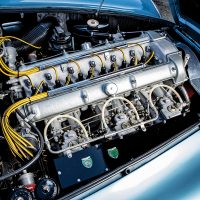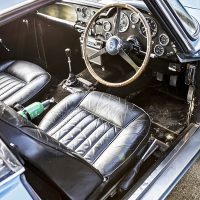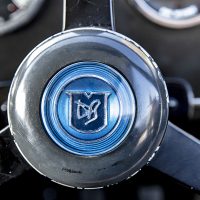SCM Analysis
Detailing
| Vehicle: | 1961 Aston Martin DB4GT “Lightweight” |
| Years Produced: | 1959–60 |
| Number Produced: | 75 (nine lightweights) |
| Original List Price: | £4,534 |
| SCM Valuation: | $3,413,500 |
| Tune Up Cost: | $1,000 |
| Distributor Caps: | $81 (two needed) |
| Chassis Number Location: | Plate on right side of scuttle |
| Engine Number Location: | On left of cylinder block next to dynamo |
| Club Info: | Aston Martin Owners Club |
| Website: | http://www.amoc.org |
| Alternatives: | 1951–58 Pegaso Z-102, 1959–61 Ferrari 250 GT berlinetta SWB, 1989–91 Aston Martin DB4GT Zagato Sanction II |
| Investment Grade: | A |
This car, Lot 9, sold for $3,109,362, including buyer’s premium, at Bonhams’ New Bond Street sale in London, U.K., on December 7, 2019.
It’s a timeworn old thing, but it wears its dings and ripples with the pride of age.
The wheelarch lips are wrong, but they’ve been there for most of the car’s life. It runs a ZF 5-speed instead of the original 4-speed, and the motor’s been enlarged from 3.7 to 4.2 liters. This capacity increase, more commonplace on DB5s, never appears to affect the value of an Aston either way, probably because the external appearance remains unchanged.
Aston Martin built only 75 DB4GTs, of which nine were to lightweight specification, plus 19 Zagato-bodied variants, one Bertone-bodied special, and five team or Development Project cars. Of the 75, 45 were supplied in right-hand drive and 30 were left-hand drive.
Aston expert Stephen Archer inspected the car before the sale, and his findings appeared in the catalog, describing the body as “well used but of great integrity. It is very rare to see a 1960s Aston in this condition,” he said. “For it to be a GT is very special and it is a truly unique lightweight DB4GT; there is no other like it. There have never been any major repairs or restoration carried out and the car’s three owners have cherished it in a very particular way. With light recommissioning, it can be used as it is. The interior can be preserved and the next owner drive a piece of history that is still an Aston Martin as built by the Works.”
Wiping away history
To restore or not represents a dilemma to many collectors. This car has been this way for half a century, so who’s to deny those lips and wrinkles their existence?
To remove them would in any case mean painting it, and making it “new” wipes out its history — it’s suddenly not the car it was.
Stephen Archer was on the side of preservation, summarizing by saying: “It would be easy to jump to the conclusion that this car needs a restoration of some magnitude. In truth, this car is an extraordinary example of originality that has been well enough preserved to be mostly retained.”
Looking around the car on the day, and absorbing all its patina, I hoped it would be sympathetically recommissioned, while leaving the body, paint and interior to silently attest their history. The original Borrani wheels remain with the car and were included in the sale.
But the trade is less sentimental.
A leading Aston Martin specialist dealer told me, “It’ll be restored. If you’re paying that much money for a car, you want it right, and it’s not original with the wheelarch lips, the Cobra wheels and the 5-speed. That’s going to cost £350k–£400k on top of the purchase price, so you’ve then got a £2.7m car.”
For once when handling a very rare piece, auctioneer James Knight didn’t quip: “It’s the only one I’ve got today,” but he could have. To be able to buy an unrestored DB4GT is pretty much a once-in-a-lifetime opportunity because these cars just don’t come to market very often.
Expensive work ahead
Well-known Aston Martin restorer and dealer Desmond Smail bought the car for an American client, who confirmed that it’s going to be “sympathetically” restored to “bring it back to as standard as possible.”
Restoring our car would put it at a final figure of about $3.6m, a little way over its supposed current market value given that the last DB4GT at auction changed hands immediately before Bonhams’ Goodwood Revival sale in September for a price believed around the lower estimate of $2.7m.
But if the owner’s investing that much, presumably they are in it for the long game.
A good time to buy?
There’s another aspect to the price paid. It’s sad if the collector-car world has become tainted by politics, but this was the high spot of a fairly dire auction by sell-through standards, with only 43% of the lots sold.
However, the timing was significant.
Bonhams’ annual season-ender of high-value cars at its New Bond Street flagship premises in London came just before the U.K.’s latest general election, at a time when Brexit gloom had hit a new low.
A week before voting, a Labour-controlled government looked a real possibility, our Labour Party being rather to the left of the Democratic Party in the United States. Rightly or wrongly, financial markets dislike a Labour government, and that tends to stifle investment and depress the pound.
When the election turned into a decisive Conservative victory, the pound immediately rallied, and high-end property started selling again, buyers having sat on their hands for the previous months.
One much-reported real-estate deal was of a £65m sale near Buckingham Palace going through just hours after the news of the result.
Although there hasn’t been a noticeable shift in the British collector-car market yet (there were no more high-end auctions in 2019), the market may rebound. This means our buyer pounced at a low spot in the market, in which case the extra investment in restoration looks justified.
We’ll only really know by the time 0169R is reborn. ♦
(Introductory description courtesy of Bonhams.)





